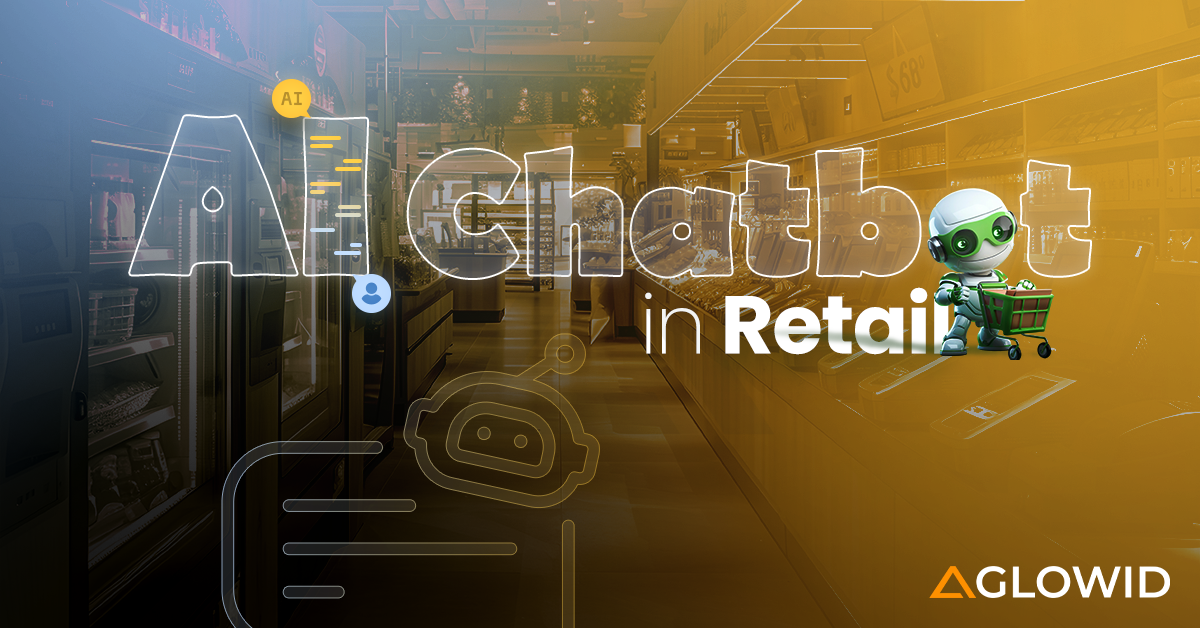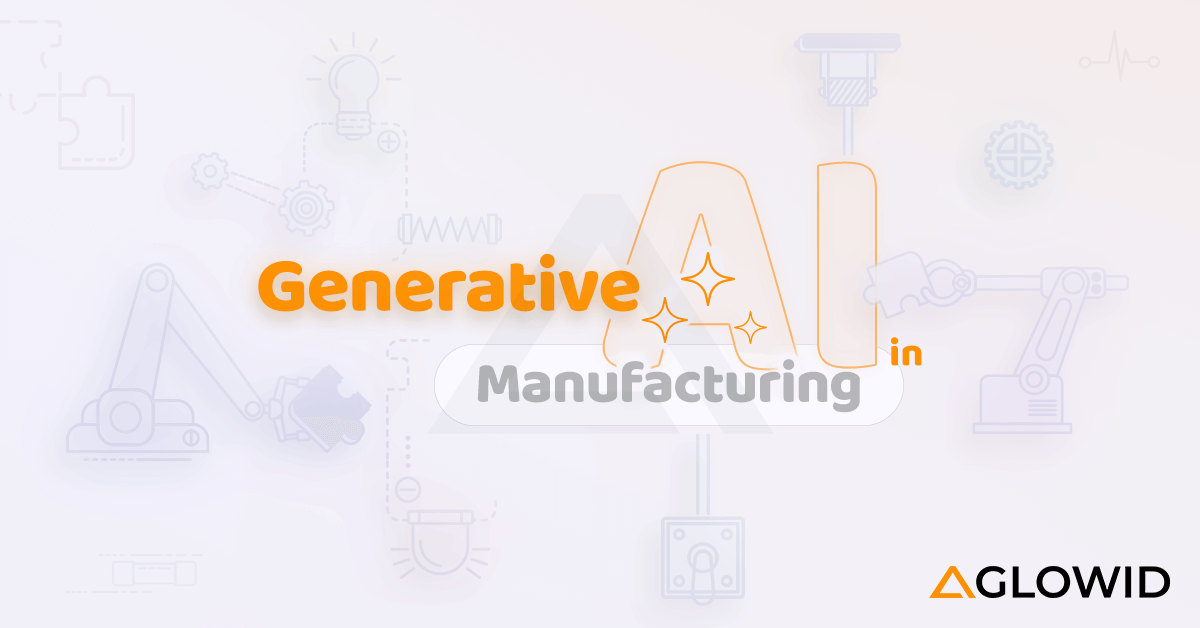Quick Summary:
Imagine shopping online with an assistant who instantly knows your preferences, effortlessly suggests products you’ll love, and streamlines your checkout… all powered by AI Retail Assistants. Behind these seamless interactions lie advanced conversational AI, Natural Language Processing (NLP), and machine learning technologies transforming the retail industry. This blog dives deep into how retailers are technically harnessing AI Assistants to enhance customer satisfaction, optimize sales, automate support, and stay ahead in retail innovation for 2025 and beyond.
In this blog, we’re going to discuss📝
Simply put, AI Retail Assistants are digital assistants designed to interact naturally with customers through text or voice messages. Using technologies like Natural Language Processing (NLP), these Assistants understand customer questions and respond instantly. Think of them as your 24/7 virtual sales assistants always available to help customers find products, answer basic questions, or even guide them through ordering online. They learn from previous conversations to become more helpful over time. In short, AI Retail Assistants make shopping easier, faster, and more personalized for customers, without needing constant human supervision.
AI Retail Assistant by the Numbers
Think AI retail Assistants are merely a passing trend? Consider the compelling statistics showcasing their rapid adoption and measurable success in recent years:
- Explosive Growth: As per reports, Global consumer spending through AI Assistants jumped from just $2.8 billion in 2019 to a staggering $142 billion in 2024.
- Customer Preference: 62% of customers now prefer interacting with AI Assistant over waiting to speak with human support.
- Daily Interaction: Approximately 54% of consumers interact with AI retail Assistants every single day demonstrating that this technology has firmly integrated into everyday shopping experiences.
Why Retailers are Adopting AI Retail Assistant?
Retailers today aren’t just racing to offer better products but they’re competing fiercely to deliver the most memorable, personalized, and seamless customer experiences. With consumers becoming increasingly tech-savvy and expectations climbing higher, brands need more than just traditional customer support; they need intuitive, smart, and responsive solutions. That’s exactly why AI Retail Assistants are swiftly becoming essential, rather than optional.
Let’s unpack some key factors driving retailers toward this AI-driven transformation:
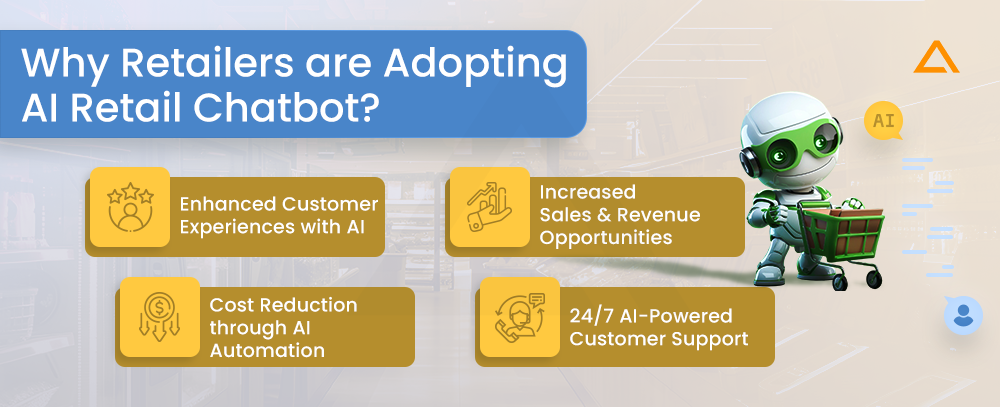
Enhanced Customer Experiences with AI
Remember your last frustrating interaction with traditional customer support like waiting on hold, explaining your issue repeatedly, and eventually feeling misunderstood? AI Assistants completely flip that experience. By leveraging Natural Language Processing (NLP) and real-time data analysis, these intelligent assistants recognize customer intent instantly and accurately, providing responses that feel personalized, relevant, and genuinely helpful.
Here’s how AI Assistants elevate customer experience:
- Instant Engagement: Customers don’t wait they get immediate, relevant answers.
- Tailored Recommendations: Assistants learn customer preferences and offer products genuinely suited to their tastes.
- Proactive Assistance: They anticipate customer needs, such as suggesting related products or addressing potential concerns before they arise.
Instead of just resolving issues, Assistants build meaningful relationships, making customers feel genuinely valued and understood.
Increased Sales and Revenue Opportunities
AI assistant don’t just enhance customer satisfaction; they significantly boost sales opportunities. Through real-time customer data, purchase histories, and browsing patterns, AI-driven Assistants recognize buying signals and proactively guide customers toward making purchases.
Here’s how AI retail chatbots translate interactions into revenue:
- Conversational Commerce: Customers complete purchases directly through assistant conversations, removing traditional friction points like abandoned carts.
- Cross-Selling & Upselling: Assistants suggest complementary products, personalized bundles, and timely promotions, naturally increasing average order value.
- Remarketing: AI Assistants follow up with customers about incomplete purchases or notify them about restocked favorites, converting potential losses into revenue gains.
Cost Reduction through AI Automation
While exceptional customer experiences and increased revenue are significant motivators, AI retail assistants also offer a critical benefit that’s irresistible for retailers: substantial cost reductions.
Implementing AI chatbots streamlines customer support processes, freeing human agents from repetitive, low-value tasks. Retailers see immediate savings, not just financially but also operationally:
- Reduced Staffing Costs: AI assistants can handle hundreds or thousands of interactions simultaneously, drastically cutting costs associated with scaling human teams.
- Improved Efficiency: Employees focus on complex, high-impact tasks rather than routine queries, boosting overall team productivity and morale.
- Fewer Human Errors: Automated assistant interactions reduce mistakes, ensuring consistency, accuracy, and reliability across customer service.
24/7 AI-Powered Customer Support
In today’s fast-paced world, customers expect immediate responses regardless of the time of day or night. AI retail assistants effortlessly meet this expectation, providing always-on support that’s both responsive and personalized.
Benefits of round-the-clock assistant availability include:
- Instant Issue Resolution: No more waiting until business hours; customers get immediate help exactly when they need it.
- Global Reach: Assistants handle customers from any time zone, extending brands’ reach and accessibility.
- Consistent Customer Service: Regardless of when or where a customer interacts, assistants provide uniform and dependable service.
To clearly illustrate, here’s a quick overview of AI retail assistants versus traditional support channels:
| Aspect | Traditional Support | AI Retail Chatbots |
| Customer Engagement | Reactive, Delayed | Proactive, Instant |
| Sales & Revenue Potential | Moderate | High |
| Operational Cost | High | Significantly Lower |
| Availability | Limited | 24/7 |
| Personalization Capability | Limited by training | AI-driven, Adaptive |
Top Use Cases of AI Retail Assistants
You’ve probably heard plenty of buzz around AI retail assistants but how exactly are retailers putting them to practical use? Let’s break down some of the top real-world use cases where AI-powered assistants are truly transforming retail operations and significantly enhancing customer experiences.
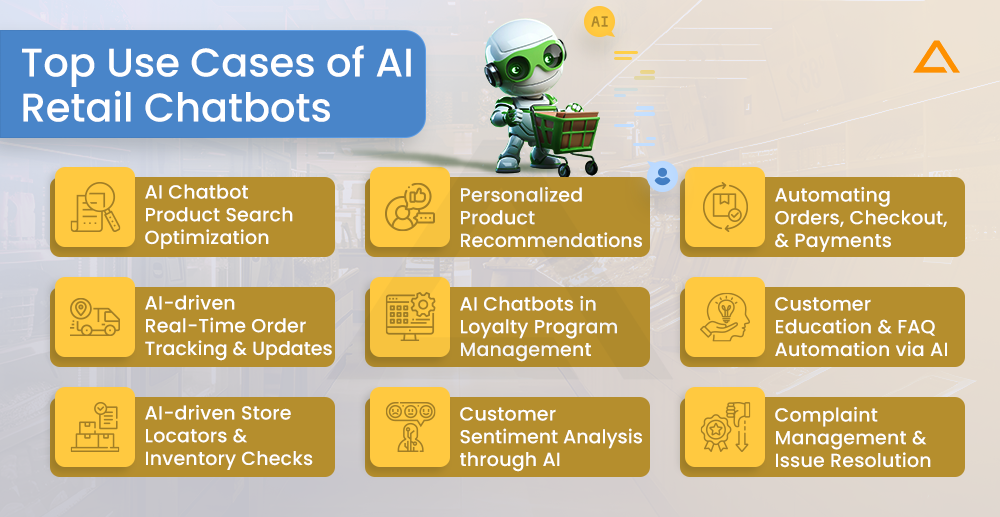
AI Assistant Product Search Optimization
Ever visited a website looking for a specific product, only to leave frustrated because you couldn’t find it? AI retail assistants tackle this exact problem by providing intelligent, conversational product searches. Instead of browsing through endless product categories, customers simply describe what they’re looking for, and the assistant instantly fetches accurate results.
Here’s why this matters:
- Simplifies Customer Journey: Reduces friction by quickly understanding what customers need.
- Increases Conversion Rates: Customers who find products faster are more likely to complete a purchase.
- Improves User Engagement: Interactive product searches encourage more frequent customer interactions.
Example Assistant Interaction (Customer):
👨🦰 Customer: “Hey, I’m looking for wireless headphones under $150.”
🤖 Assistant: “Got it! Here are some top-rated wireless headphones priced below $150. Would you prefer over-ear or earbuds?”
AI-powered Personalized Product Recommendations
One-size-fits-all is outdated, today’s consumers crave tailored experiences. AI retail assistants leverage advanced machine learning algorithms to analyze purchase histories, browsing behaviors, and even social interactions. The result? Product recommendations that are genuinely relevant and personalized, making each shopper feel uniquely valued.
Key benefits include:
- Higher Customer Satisfaction: Personalization boosts customer happiness and loyalty.
- Boosted Sales: Customers buy more when products match their tastes.
- Enhanced Brand Image: Brands that provide personalization stand out from the competition.
Example Assistant Interaction (Employee):
🤖 Assistant to Sales Associate: “Customer #592 browsed premium watches frequently. Consider suggesting the latest luxury collection next time they visit our store.”
Automating Orders, Checkout, and Payments
Cart abandonment is a huge pain point for retailers. AI retail Assistants dramatically streamline the buying process, allowing customers to select products, confirm orders, and securely handle payments all within the assistant conversation itself.
This reduces common shopping hurdles:
- Fewer Abandoned Carts: Immediate checkout via chat minimizes distractions or second thoughts.
- Seamless User Experience: Customers avoid multiple web pages and forms, significantly improving conversion rates.
- Reduced Errors: AI automates data entry, ensuring accuracy in transactions.
Example Assistant Interaction (Customer):
👷 Customer: “Please reorder my last coffee order.”
🤖 Assistant: “Sure! Your last order was a 2lb bag of Dark Roast. Shall I confirm and charge your saved card ending in 1234?”
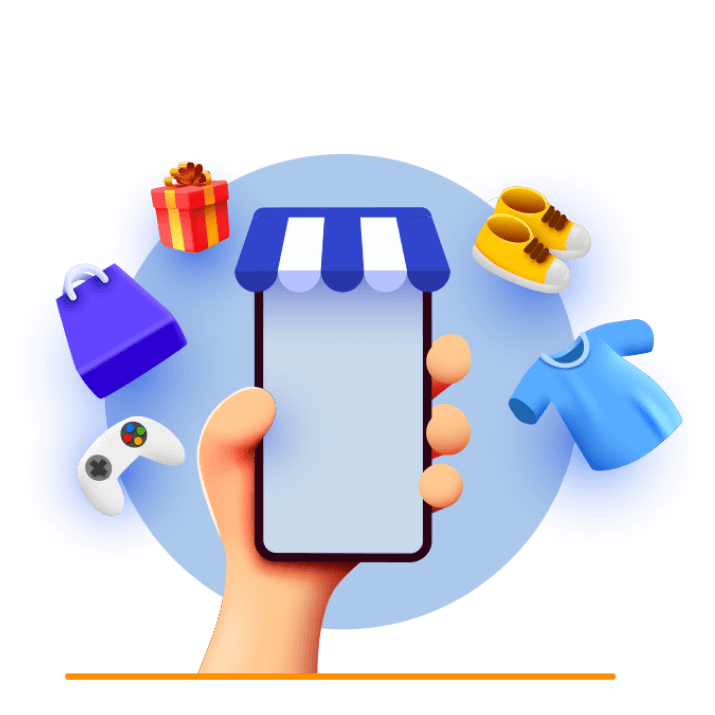
Hunting for Retail IT Solutions?
Transform retail challenges into success stories with our cutting-edge AI-powered solutions, designed to drive growth, efficiency, and seamless customer experiences!
AI-driven Real-Time Order Tracking and Updates
“Where is my order?” is probably the most common customer question retailers face. With AI retail assistants, customers no longer need to call support or search through emails. They simply ask their assistant and instantly receive precise updates on shipping status, estimated delivery dates, and tracking information.
This creates real value by:
- Reducing Customer Anxiety: Instant updates eliminate uncertainty.
- Lowering Support Costs: Fewer calls and emails free up resources.
- Building Customer Trust: Transparency in shipping builds customer confidence.
Example Assistant Interaction (Customer):
👷 Customer: “Where is my recent order?”
🤖 Assistant: “Your order #2514 is on its way! It’s scheduled for delivery tomorrow between 10 AM and 2 PM. Would you like tracking details?”
AI Assistants in Loyalty Program Management
Let’s face it: loyalty programs can be complicated, and customers often lose track of their points, rewards, and available offers. AI retail assistants proactively remind customers about loyalty benefits, available points, upcoming expiration dates, and relevant promotions.
Key impacts include:
- Increased Loyalty Engagement: Reminders encourage repeat business.
- More Effective Promotions: Personalized loyalty promotions boost conversions.
- Improved Customer Retention: Active engagement through rewards programs keeps customers loyal.
Example Assistant Interaction (Employee):
🤖 Assistant to Loyalty Program Manager: “Currently, 340 customers have loyalty points expiring this month. Do you want me to send them reminders and personalized promotions?”
Customer Education and FAQ Automation via AI
Handling repetitive queries like return policies or product specifications can be time-consuming. AI retail assistants automate these common questions, instantly offering accurate responses. This not only helps customers find answers quickly but also frees up your human support team to focus on more complex issues.
Here’s how FAQ automation adds value:
- Immediate Answers: Customers receive instant responses, improving satisfaction.
- Operational Efficiency: Automation frees staff to handle high-value interactions.
- Consistency and Accuracy: Standardized responses ensure reliability across all interactions.
Example Assistant Interaction (Customer):
👩 Customer: “What’s your return policy?”
🤖 Assistant: “We offer a 30-day hassle-free return policy. Would you like detailed instructions on how to start a return?”
AI-driven Store Locators and Inventory Checks
Sometimes customers find a product online but prefer to buy or pick it up at a nearby physical store. AI retail assistants effortlessly integrate store locators and real-time inventory checks. Customers simply ask, “Is this available near me?” and the assistant responds immediately.
Benefits of this functionality:
- Bridging Digital and Physical Shopping: Offers omnichannel convenience.
- Boosted In-store Traffic: Encourages online visitors to physically visit stores.
- Improved Inventory Management: Customers avoid frustration from out-of-stock items.
Example Assistant Interaction (Customer):
👩 Customer: “Is the Dyson vacuum available at a nearby store?”
🤖 Assistant: “Yes, the Dyson V11 is currently available at our downtown store, just 2 miles from your location. Would you like directions?”
Customer Sentiment Analysis through AI
Understanding customer emotions and satisfaction can be challenging but AI retail assistants use sentiment analysis to interpret customer interactions and gauge their mood. By analyzing conversations, they can flag dissatisfied customers or highlight positive experiences for follow-up.
Practical advantages include:
- Early Issue Identification: Addressing dissatisfaction proactively prevents escalations.
- Targeted Marketing Efforts: Positive sentiment can inform future product recommendations.
- Enhanced Customer Insights: Retailers better understand overall customer attitudes and experiences.
Example Assistant Interaction (Employee):
🤖 Assistant to Customer Support Agent: “Customer #347 appears frustrated due to delayed shipping. Consider offering expedited delivery or a discount code to resolve the situation.”
AI-based Complaint Management and Issue Resolution
No one enjoys handling complaints, but timely, empathetic responses are essential for customer retention. AI retail assistant streamline complaint handling by collecting detailed information upfront and escalating complex issues directly to human representatives when needed.
This leads to tangible improvements:
- Faster Resolution: Quick AI response reduces frustration and resolves issues swiftly.
- Efficient Workflow: Structured complaint management optimizes human team efforts.
- Improved Customer Satisfaction: Prompt, empathetic handling helps rebuild customer trust.
Example Assistant Interaction (Customer):
👩 Customer: “The product I received is damaged.”
🤖 Assistant: “I’m very sorry to hear that! Can you upload a quick photo of the damage? I’ll immediately start the replacement process for you.”
By illustrating both customer-facing and internal employee-facing scenarios, you can clearly visualize how AI retail assistants provide strategic benefits across multiple touchpoints. Curious how some of your favorite brands are leveraging these AI-driven tools? Let’s explore some powerful real-world examples next.
Real-World Examples of Successful AI Retail Assistants
Stories resonate more than abstract explanations ever can. Let’s explore in greater detail how some of the world’s leading brands have leveraged AI retail assistants to enhance customer relationships and streamline internal operations. We’ll deep-dive into their strategies, highlight their standout features, and see real interactions that illustrate precisely how these brands have transformed shopping experiences and operational efficiency.
Sephora’s AI Virtual Beauty Assistant
Standout Feature:
Sephora’s Virtual Beauty Assistant incorporates augmented reality (AR) and advanced NLP to allow customers to use AI-powered virtually “try on” makeup, matching shades and styles to each individual’s preferences.
Sephora recognized a key hurdle in online cosmetics shopping: customers can’t physically test products. To solve this, Sephora integrated AR capabilities directly into their assistant, making the online experience engaging and interactive.
Business Impact:
- Improved Online Conversions: Customers who virtually try products are more likely to purchase confidently, reducing returns and boosting overall sales.
- Enhanced Customer Satisfaction: Personalized recommendations tailored to each customer’s skin type and preferences have significantly improved user satisfaction.
Example Interaction (Customer):
- 👩 Customer: “I want to find a foundation that matches my skin tone.”
- 🤖 Sephora Assistant: “Great! Please activate your camera for a quick shade match. We’ll find the perfect match together!”
H&M’s Kik AI Retail Assistant
Standout Feature:
H&M cleverly leverages the Kik messaging platform to run interactive style quizzes, analyze customer preferences, and offer personalized outfit recommendations. Instead of generic fashion suggestions, H&M’s AI assistant genuinely learns customer tastes.
This method allows H&M to understand each shopper’s style deeply, enabling the assistant to suggest products that feel handpicked.
Business Impact:
- Higher Engagement Rates: Interactive quizzes significantly increased user engagement and dwell time on the platform.
- Boosted Average Order Value: Customers typically bought more products per session when guided by personalized recommendations.
Example Interaction (Customer):
- 👩 Customer: “I have an office party next week…any style recommendations?”
- 🤖 H&M Assistant: “Sure! Let’s do a quick style check, do you prefer a chic professional look or something casual yet classy?”
Nike’s AI Retail Assistant
Standout Feature:
Nike’s AI chatbot integrates digital and physical shopping experiences by offering real-time inventory information, product reservations, and seamless in-store pickups directly through chat.
Nike realized that customers often want to confirm product availability before visiting stores. The assistant acts as a personal shopping assistant, bridging online convenience with physical retail interactions.
Business Impact:
- Increased Foot Traffic: Clear, real-time information increased store visits, turning digital interactions into physical store sales.
- Improved Customer Experience: Seamless omnichannel integration fostered higher customer loyalty and satisfaction.
Example Interaction (Customer):
- 👩 Customer: “Are Nike Blazers available near me?”
- 🤖 Nike Assistant: “Yes! Your local Nike store downtown has the Blazers in stock. Want me to hold a pair for pickup today?”
American Eagle’s AI Retail Assistant
Standout Feature:
American Eagle’s Assistant operates exclusively through Facebook Messenger, effectively transforming the social media platform into an active sales channel. It offers personalized product updates, promotions, and real-time support right where customers already interact socially.
Instead of trying to draw customers onto their website or app, American Eagle decided to meet them where they already spend time on social media. This approach directly increased engagement, conversion rates, and brand interactions.
Business Impact:
| Metric | Before AI Assistant | After AI Assistant |
| Click-through Rates (CTR) | Moderate (12%) | High (25%) |
| New Customer Acquisition | Average | Increased by 75% |
Example Interaction (Customer):
- 👩 Customer: “Looking for deals on hoodies.”
- 🤖 AE Assistant: “Perfect timing! we have a special offer today! Buy one hoodie, get one at 50% off. Here are some popular styles.”
Staples Integrating IBM Watson’s AI Retail Assistant
Standout Feature:
Staples implemented IBM Watson’s AI assistant to automate order management, streamline inventory tracking, and handle frequent customer queries through various platforms, including Facebook Messenger, Slack, and SMS.
Staples not only improved external customer experiences but also enhanced internal operations. The assistant helps Staples employees monitor inventory levels proactively, initiating automatic replenishments and reducing human error.
Business Impact:
| Operational Metric | Before AI Assistant | After AI Assistant |
| Inventory Stock-outs | Frequent | Reduced significantly |
| Efficiency in Order Management | Manual, labor-intensive | Automated, streamlined |
Example Interaction (Employee – Internal):
- 🔔 Assistant Notification: “Inventory Alert: Printer ink for Model XYZ is low (under 10 units). Should I reorder 100 units from the usual supplier?”
Technical Guide for Building an Effective AI Retail Assistant
Bringing AI Retail Assistants into your retail business can be a game changer, but understanding how to effectively implement them can feel overwhelming. Don’t worry we’ve got you covered. In this technical guide, we’ll walk step-by-step through the essential components required to build powerful and effective AI retail Assistants.
Types of AI Retail Assistants
Not all AI retail assistants are created equal; there are primarily two types, each with distinct characteristics and ideal use cases:

Rule-based AI Retail Assistants
Rule-based chatbots function by following a predefined set of rules. They’re effective in managing structured, predictable interactions like answering FAQs about store hours, return policies, or delivery information. These assistants provide straightforward, efficient customer support without unnecessary complexities.
Ideal use cases:
- Answering frequently asked questions (FAQs)
- Providing basic order status or product availability information
- Simple customer education or guidance
Conversational AI-powered Retail Assistants
Conversational AI-powered assistants represent the next level of sophistication. They leverage NLP, machine learning, and data analytics to provide dynamic, context-aware responses. They don’t just follow rules but learn, evolve, and become smarter with every interaction.
Ideal use cases:
- Personalized product recommendations
- Complex order processing and checkout
- Understanding and responding to customer sentiment and intent
- Handling nuanced or multi-step customer queries
Understanding these assistant types enables retailers to select and implement the right AI-driven solutions tailored specifically to their unique customer needs and business goals.
Whether you’re a tech lead, retail manager, or simply AI-curious, let’s explore together how to practically make these assistants a reality in your retail business.
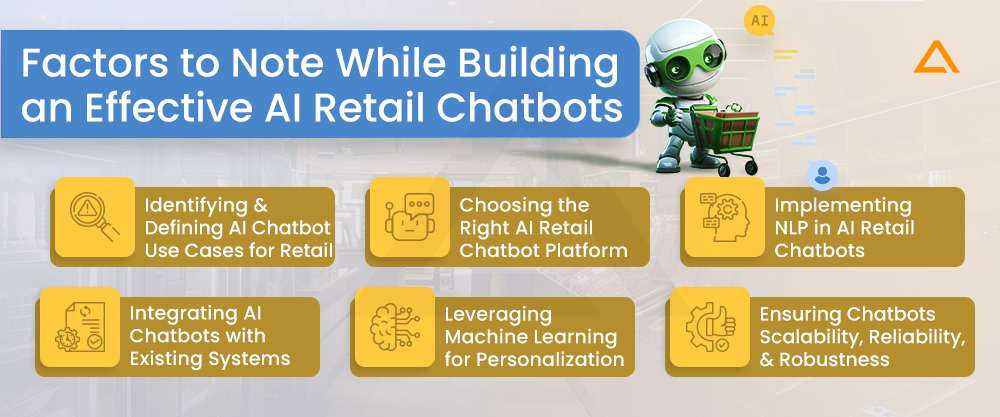
Identifying and Defining AI Assistant Use Cases for Retail
Every successful AI implementation begins with clearly defining your assistant use cases. To set a solid foundation, first ask yourself: What specific problems do we aim to solve, and how can AI retail chatbots address them?
Here’s how you can approach this:
- Map Out Customer Pain Points: Identify common frustrations like lengthy searches, slow customer support, inventory confusion and than prioritize use cases that directly resolve these pain points.
- Align Assistant Goals with Business Objectives: Clearly outline goals such as increased sales, enhanced customer engagement, or operational efficiency.
- Specify User Interactions: Determine if your AI retail assistant will manage product recommendations, order tracking, loyalty points, or customer support.
Here’s a simple framework to follow:
| Pain Point | Assistant Use Case | Expected Outcome |
| Customers can’t find products easily | AI Assistant Product Search | Higher conversion rates |
| High cart abandonment rate | Automated Checkout & Payments | Reduced abandoned carts |
| Poor customer loyalty engagement | Loyalty Program Management | Increased customer retention |
Choosing the Right AI Retail Assistant Platform
Once you’ve clarified your assistants purpose, the next critical step is selecting the right AI retail chatbot platform. There’s a wide range of solutions on the market each with distinct strengths, features, and integration capabilities.
Overview of Leading Solutions: IBM Watson Assistant, Tidio, Drift
| Platform | Best Suited For | Key Strengths |
| IBM Watson Assistant | Enterprises needing robust integration capabilities | Advanced NLP, deep analytics, seamless integration with existing enterprise systems |
| Tidio | Small to mid-sized retailers seeking ease-of-use | User-friendly drag-and-drop interface, affordable, quick deployment |
| Drift | B2B retailers prioritizing sales-driven interactions | Strong sales enablement features, real-time lead generation, customer segmentation |
When selecting your platform, consider factors such as scalability, integration with current systems, cost-effectiveness, and the complexity of assistant interactions you plan to handle.
Example Internal Evaluation (Employee):
- Tech Lead: “Considering our high CRM usage and complex inventory systems, IBM Watson Assistant seems ideal due to its enterprise integration options.”
Implementing Natural Language Processing (NLP) in AI Retail Assistants
NLP is the backbone of conversational AI, enabling assistants to understand human language, intent, and context. Effective NLP implementation ensures your assistant feels natural, intuitive, and engaging to customers.
Here’s why NLP matters in retail assistants:
- Accurate Intent Recognition: NLP identifies customer intentions accurately, reducing frustration from misunderstood queries.
- Conversational Human-like Interaction: A conversational AI assistant engages users naturally, enhancing user satisfaction.
- Multilingual Support: Proper NLP implementation accommodates multiple languages, expanding your customer reach.
Example NLP-based Interaction (Customer):
- 👩 Customer: “Any good laptops under $500?”
- 🤖 Assistant (with NLP): “Here are top-rated laptops within your budget. Do you prefer a specific brand?”
Integrating AI Retail Assistants with Existing Systems (CRM, Inventory, ERP)
Integrating your assistant with existing systems such as CRM, ERP, or inventory management software ensures it delivers real-time, accurate information.
Benefits include:
- Real-time Inventory Visibility: Assistants can instantly verify product availability and inform customers accordingly.
- Seamless Order Management: Automate order placement, confirmations, and tracking via direct ERP integrations.
- Improved Customer Profiles: Update CRM databases with assistant conversations to enhance future personalized marketing and support.
Example Internal Scenario (Employee):
- 🔔Assistant (Employee Alert): “Customer #723 requested a product that’s out of stock. I’ve automatically flagged this in the inventory system for restocking.”
Leveraging Machine Learning for Personalization
Machine learning (ML) helps AI retail assistants deliver personalized experiences at scale. By analyzing historical customer interactions, purchases, and behaviors, ML enables assistants to tailor suggestions, offers, and interactions uniquely for each user.
To effectively leverage ML, retailers should:
- Gather and Structure Data: Collect customer interaction data to train ML models effectively.
- Continuous Learning: Deploy continuous feedback loops so the assistant learns and improves interactions over time.
- Predictive Recommendations: Employ predictive analytics to proactively suggest products or solutions tailored to individual preferences.
Example Customer Scenario:
- 👩 Customer: “I’m looking for running shoes.”
- 🤖 Assistant (ML-driven): “Considering your recent search for Nike gear, I recommend the latest Nike Pegasus running shoes. They perfectly match your recent preferences.”
Ensuring Scalability, Reliability, and Robustness of AI Retail Assistants
Finally, your assistant must be scalable, reliable, and robust to handle the realities of retail operations:
- Scalability: Design assistants that can easily handle increased user demand during peak periods like holiday seasons or sales events.
- Reliability: Ensure uptime, low latency, and consistent assistant performance through regular monitoring and testing.
- Robustness: Anticipate and gracefully manage unexpected user queries or system errors, maintaining a positive customer experience.
Technical Considerations to Ensure Stability:
- Regularly conduct stress-testing and performance monitoring.
- Implement failover mechanisms to maintain availability.
- Regularly update your NLP and ML models for optimal accuracy and performance.
Example Internal Scenario (Employee):
- 🔔 Tech Support Notification: “Assistant performance alert: User query processing slowed by 15% during peak hours. Recommend scaling server resources.”
Future of AI Retail Assistants
If the past decade taught us anything, it’s that retail technology moves fast. AI Retail Chatbots are no exception, evolving rapidly from basic customer support tools to sophisticated, intuitive digital assistants. But what’s next? Let’s fast-forward a bit and visualize how the retail landscape, shaped by AI, might look by the end of this decade.

Conversational Commerce Meets Generative AI
As generative AI Service such as GPT-4 evolve, retail assistants will move beyond scripted interactions and simple FAQ responses. The future will bring conversational commerce to life through fluid, human-like dialogues, capable of dynamically generating responses in real-time based on customers’ individual styles, tones, and preferences.
How might this look in practice?
Imagine shopping for a new wardrobe with an AI assistant that not only suggests outfits based on your style but engages you conversationally:
👩 Customer: “I have a big presentation tomorrow.. help me impress!”
🤖 AI Assistant (Generative AI-powered): “Absolutely! Based on your recent purchases, a sharp navy blazer paired with charcoal trousers would be perfect. Want to see how it’d look with a few different shirt combinations?”
Potential Impact:
- Increased emotional connection with customers
- Greater personalization at scale, enhancing customer retention
- Dramatic improvements in conversion rates and customer satisfaction
AI Assistants Integrated with AR and VR
By 2030, AI retail assistants will frequently interact with Augmented Reality (AR) and Virtual Reality (VR) to redefine customer engagement completely. Combining intelligent assistant interactions with immersive technology opens a realm of possibilities:
- Virtual Store Visits: Customers could browse a store from their living room, guided by an AI assistant avatar.
- AR-Enhanced Product Trials: Customers virtually try clothes, accessories, or furniture with personalized guidance from the assistant.
Here’s how such an interaction could play out:
👩 Customer (via AR): “Can I see this sofa in my living room?”
🤖 Assistant (AR-powered): “Absolutely. Activate your camera, and let’s virtually place it in your space. I’ll help you check dimensions and pick the best color match.”
Potential Impact:
| Aspect | Expected Outcome by 2030 |
| Online Purchases | More confident decisions, fewer returns |
| Customer Satisfaction | Significant improvement due to immersive experiences |
| Competitive Advantage | Early adopters significantly ahead of competitors |
Voice-Activated AI Retail Shopping Assistants
Voice technology has already become common in our daily lives with devices like Alexa or Siri. By 2030, voice-activated AI shopping assistants will likely be the norm in retail too which makes shopping simpler, faster, and hands-free.
Imagine this scenario on your morning commute:
👩 Customer (voice interaction): “Hey ShopBot, I forgot to reorder coffee beans. Can you get me my usual?”
🤖 AI Voice Assistant: “Got it! Ordering your favorite dark roast beans, expected delivery tomorrow afternoon. Want me to add anything else to your cart?”
Potential Impact:
- Increased convenience and accessibility
- Expanded sales opportunities through effortless ordering
- Improved customer loyalty from ease-of-use
Predictive Analytics
Predictive analytics, driven by advanced machine learning models, will revolutionize how assistants engage customers. AI retail assistants will no longer just react but they’ll predict customer behaviors and proactively address needs even before customers realize them.
What might proactive support look like?
- Automatically recommending product replacements based on purchase cycles
- Preemptively alerting customers of potential issues, such as delayed shipping or low inventory for recurring orders
- Personalized product launches, exclusively tailored to individual customer preferences and buying patterns
Realistic Example:
🔔 AI Assistant Notification: “Hi Alex, your running shoes are about six months old and have logged over 400 miles. This would be a great time to replace them for optimal support. Here’s a personalized recommendation based on your recent runs.”
Potential Impact:
- Deeper customer trust and brand loyalty
- Enhanced customer lifetime value (CLV)
- Significant competitive differentiation

Seeking brilliance in the AI/ML universe?
Look no further!
Conclusion
In an increasingly competitive retail landscape, adopting AI Retail Assistants isn’t just beneficial but it’s essential. Retail brands aiming for sustained growth and superior customer experiences must strategically harness assistant capabilities, including personalization, predictive analytics, and immersive interactions. By clearly defining objectives, choosing the right platforms, and continually refining assistant performance, retailers can significantly enhance customer satisfaction, streamline operations, and drive higher revenues. To future-proof their businesses, brands should proactively embrace evolving AI technologies, such as voice assistance, generative AI, and AR/VR integrations, positioning themselves as market leaders in a customer-driven era.
